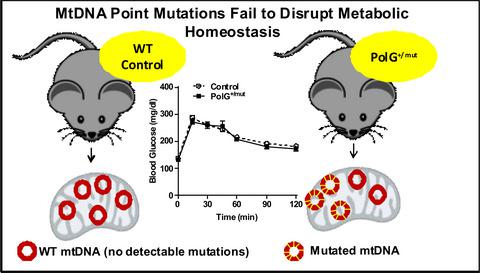当前位置:
X-MOL 学术
›
Aging Cell
›
论文详情
Our official English website, www.x-mol.net, welcomes your
feedback! (Note: you will need to create a separate account there.)
Age‐induced mitochondrial DNA point mutations are inadequate to alter metabolic homeostasis in response to nutrient challenge
Aging Cell ( IF 8.0 ) Pub Date : 2020-10-13 , DOI: 10.1111/acel.13166 Timothy M Moore 1, 2 , Zhenqi Zhou 2 , Alexander R Strumwasser 2 , Whitaker Cohn 3 , Amanda J Lin 2 , Kevin Cory 2 , Kate Whitney 2 , Theodore Ho 2 , Timothy Ho 2 , Joseph L Lee 2 , Daniel H Rucker 2 , Austin N Hoang 2 , Kevin Widjaja 2 , Aaron D Abrishami 4 , Sarada Charugundla 4 , Linsey Stiles 2 , Julian P Whitelegge 3 , Lorraine P Turcotte 1 , Jonathan Wanagat 2 , Andrea L Hevener 2, 5
Aging Cell ( IF 8.0 ) Pub Date : 2020-10-13 , DOI: 10.1111/acel.13166 Timothy M Moore 1, 2 , Zhenqi Zhou 2 , Alexander R Strumwasser 2 , Whitaker Cohn 3 , Amanda J Lin 2 , Kevin Cory 2 , Kate Whitney 2 , Theodore Ho 2 , Timothy Ho 2 , Joseph L Lee 2 , Daniel H Rucker 2 , Austin N Hoang 2 , Kevin Widjaja 2 , Aaron D Abrishami 4 , Sarada Charugundla 4 , Linsey Stiles 2 , Julian P Whitelegge 3 , Lorraine P Turcotte 1 , Jonathan Wanagat 2 , Andrea L Hevener 2, 5
Affiliation

|
Mitochondrial dysfunction is frequently associated with impairment in metabolic homeostasis and insulin action, and is thought to underlie cellular aging. However, it is unclear whether mitochondrial dysfunction is a cause or consequence of insulin resistance in humans. To determine the impact of intrinsic mitochondrial dysfunction on metabolism and insulin action, we performed comprehensive metabolic phenotyping of the polymerase gamma (PolG) D257A “mutator” mouse, a model known to accumulate supraphysiological mitochondrial DNA (mtDNA) point mutations. We utilized the heterozygous PolG mutator mouse (PolG+/mut) because it accumulates mtDNA point mutations ~ 500‐fold > wild‐type mice (WT), but fails to develop an overt progeria phenotype, unlike PolGmut/mut animals. To determine whether mtDNA point mutations induce metabolic dysfunction, we examined male PolG+/mut mice at 6 and 12 months of age during normal chow feeding, after 24‐hr starvation, and following high‐fat diet (HFD) feeding. No marked differences were observed in glucose homeostasis, adiposity, protein/gene markers of metabolism, or oxygen consumption in muscle between WT and PolG+/mut mice during any of the conditions or ages studied. However, proteomic analyses performed on isolated mitochondria from 12‐month‐old PolG+/mut mouse muscle revealed alterations in the expression of mitochondrial ribosomal proteins, electron transport chain components, and oxidative stress‐related factors compared with WT. These findings suggest that mtDNA point mutations at levels observed in mammalian aging are insufficient to disrupt metabolic homeostasis and insulin action in male mice.
中文翻译:

年龄诱导的线粒体 DNA 点突变不足以改变代谢稳态以应对营养挑战
线粒体功能障碍通常与代谢稳态和胰岛素作用受损有关,并且被认为是细胞衰老的基础。然而,目前尚不清楚线粒体功能障碍是人类胰岛素抵抗的原因还是结果。为了确定线粒体内在功能障碍对代谢和胰岛素作用的影响,我们对聚合酶 γ (PolG) D257A“突变体”小鼠进行了全面的代谢表型分析,该模型已知会积累超生理线粒体 DNA (mtDNA) 点突变。我们使用杂合 PolG 突变小鼠 (PolG +/mut ),因为它积累的 mtDNA 点突变约为 > 野生型小鼠 (WT) 的 500 倍,但与 PolG mut/mut动物不同,它未能形成明显的早衰表型。为了确定 mtDNA 点突变是否会导致代谢功能障碍,我们检查了 6 个月和 12 个月大的雄性 PolG +/mut小鼠在正常饮食喂养、24 小时饥饿后以及高脂饮食 (HFD) 喂养后的情况。在任何研究条件或年龄期间,WT 和 PolG +/mut小鼠之间的葡萄糖稳态、肥胖、代谢的蛋白质/基因标记或肌肉耗氧量均未观察到显着差异。然而,对 12 个月大 PolG +/mut小鼠肌肉的分离线粒体进行的蛋白质组学分析显示,与 WT 相比,线粒体核糖体蛋白、电子传递链成分和氧化应激相关因子的表达发生了变化。这些发现表明,在哺乳动物衰老过程中观察到的线粒体DNA点突变不足以破坏雄性小鼠的代谢稳态和胰岛素作用。
更新日期:2020-11-23
中文翻译:

年龄诱导的线粒体 DNA 点突变不足以改变代谢稳态以应对营养挑战
线粒体功能障碍通常与代谢稳态和胰岛素作用受损有关,并且被认为是细胞衰老的基础。然而,目前尚不清楚线粒体功能障碍是人类胰岛素抵抗的原因还是结果。为了确定线粒体内在功能障碍对代谢和胰岛素作用的影响,我们对聚合酶 γ (PolG) D257A“突变体”小鼠进行了全面的代谢表型分析,该模型已知会积累超生理线粒体 DNA (mtDNA) 点突变。我们使用杂合 PolG 突变小鼠 (PolG +/mut ),因为它积累的 mtDNA 点突变约为 > 野生型小鼠 (WT) 的 500 倍,但与 PolG mut/mut动物不同,它未能形成明显的早衰表型。为了确定 mtDNA 点突变是否会导致代谢功能障碍,我们检查了 6 个月和 12 个月大的雄性 PolG +/mut小鼠在正常饮食喂养、24 小时饥饿后以及高脂饮食 (HFD) 喂养后的情况。在任何研究条件或年龄期间,WT 和 PolG +/mut小鼠之间的葡萄糖稳态、肥胖、代谢的蛋白质/基因标记或肌肉耗氧量均未观察到显着差异。然而,对 12 个月大 PolG +/mut小鼠肌肉的分离线粒体进行的蛋白质组学分析显示,与 WT 相比,线粒体核糖体蛋白、电子传递链成分和氧化应激相关因子的表达发生了变化。这些发现表明,在哺乳动物衰老过程中观察到的线粒体DNA点突变不足以破坏雄性小鼠的代谢稳态和胰岛素作用。











































 京公网安备 11010802027423号
京公网安备 11010802027423号